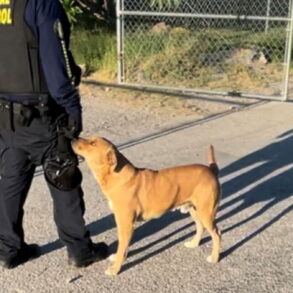
A pair of dogs dig for breakfast outside a gas station in Las Vegas.
If you live in Las Vegas, you know about the dogs.
You know there are large dog packs running on the streets. Maybe your grandma doesn’t want to walk down by the river because she doesn’t feel safe. Some are feral, while others are pets, and they run all over the place.
Everyone has an opinion about what to do, but things don’t seem to change.
This series will look at animal control issues in Las Vegas, from a solution-oriented point of view, exploring not just the problem, but what we might be able to do about it.
•••
Throughout this series, we have discussed what Las Vegas is doing about its animal control issues. From expanding spay and neuter clinics, to improving shelter facilities, to the role of volunteers and the community, Las Vegas’ proposed solutions have been explained.
This final installment will look at what other communities across New Mexico are doing to combat similar issues, with varying degrees of success.
Portales plans new animal shelter, adopts new ordinance
Kelly McClellan, community services director for the city of Portales, said that until recently the eastern New Mexico town also dealt with packs of dogs running loose. In an effort to combat this problem, Portales is in the process of building a new, improved animal shelter.
“That’s part of how we got our new facility,” McClellan said. “We applied for emergency funding, because we had such large packs of dogs and there were safety issues.”
The City of Portales requested emergency funding from the New Mexico Board of Finance, which awarded $350,000 earlier this year for the design and construction of the animal shelter building.
Portales is currently working with a temporary animal shelter, McClellan said. Despite their limited sheltering capacity, city staff are still working hard to limit the number of roaming animals. McClellan said city staff recently helped remove about 106 animals off the street in a 30-day period. Some were feral cats, McClellan said, but most were dogs.
These animals found temporary accommodation at the city’s temporary animal shelter, McClellan aid, and staff worked really hard with rescues that have extensive foster networks to find the animals alternative housing.
“We’re still a no-kill shelter technically because we euthanize less than 10 percent of what comes in,” McClellan said. “So, 90 percent of that (106) was still able to go out to a rescue, be adopted or be fostered.”
There are hopes that the city’s new animal care facility will have 32 kennels for dogs as well as a cat room. This will be a more expansive facility than the one the city has now, McClellan said, which will hopefully extend the amount of time the shelter can hold on to animals that are brought in.
“We don’t really extend more than two weeks for a dog,” McClellan said of the shelter’s holding capacity. “We’re hoping that by having more kennels and having more room that we can hold (the animals) a bit longer and ease that burden off the rescue partners that we have.”
Aside from the new animal shelter, Portales has also recently revamped its animal ordinance. The effort to create the new ordinance was spearheaded by McClellan, who took over the city’s animal shelter in July 2023.
The city’s old animal ordinance had not been updated since 2009. Its most recent update makes it stricter, McClellan said, and also addresses issues Portales is currently facing.
“There were a number of new issues that occurred that the ordinance did not cover, or problems the old ordinance was struggling with in terms of enforcement,” McClellan said.
As part of changing the ordinance, McClellan said, Portales staff “worked hard on the problems that we saw and the areas we wanted improved. … But we also had a town hall, where we requested public recommendations on what (changes the public) wanted to see.”
Ideas for the new ordinance were then sent to local rescue organizations and animal welfare organizations for their opinions, McClellan said. After undergoing this process, McClellan said, Portales’ city council adapted the new ordinance in September.
Before the ordinance went into effect, there was no fee assessed for dogs roaming at large. McClellan said there was a long period of verbal warnings prior to the new ordinance taking effect, so the community would be aware that soon there would be consequences for allowing their dogs to roam.
“We made sure we gave everybody verbal warnings (and we) worked on education of the dangers of letting your dog run loose and what the repercussions were,” McClellan said.
McClellan said Portales has one full-time animal control officer who works Monday through Friday, and another who works on a part-time basis on Saturday and Sunday. McClellan said that Portales animal control can issue citations and that when this happens the issue generally goes to court, where a judge decides on how much the citation is going to be.
Fees range from $50-$500, McClellan said, depending on the severity of the citation or how many times they’ve been cited.
The cited person can argue against the citation, McClellan said, or ask for leniency from the judge.
McClellan said she hopes all of the efforts done by the city of Portales are lowering the number of dogs running at large. She said she’s noticed fewer dogs at large and has received fewer complaints about them.
“We’ve been dwindling the packs down, but we still have a very large problem (with) free-roaming dogs,” she said.
“We’re just going to keep working and try to have short term solutions that will hopefully have long-term effects.”
Silver City focuses on animal code enforcement to deter loose dogs
Vickie Toney, animal control/code enforcement for the town of Silver City, said she has been at the post for almost nine years. Said that when she first started, there was a “large quantity” of dogs running at large in the southwest New Mexico town.
That changed, she said, as members of the community learned that there is an animal control in Silver City.
“Over the years of people getting to know that there is an animal control officer … people are becoming more responsible for their animals,” Toney said. She said the town added an additional animal control officer about two years ago.
“I’ve been blasted all over Facebook for all sorts of different things, because I catch (people’s) dogs … and hold them responsible,” Toney said.
Toney is one of three animal control officers in Silver City. One is a supervisor who is also a Silver City police officer, Manual Jaure.
All three can make citations, Toney said, and Jaure has arresting powers. Toney said that animal code citations go to the municipal court, then the person cited gets a summons to appear in court. The person then has the option to plead guilty, not guilty or no contest.
“When they plead no contest or guilty, the judge issues the fine and they make payments or do community service or whatever the case may be,” Toney said. Pleading not guilty can lead to a trial.
“We would put on our case, they would put on their case, and then the judge would determine if they’re guilty or not,” Toney said.
In order to present a case properly, Toney said, she has attended prosecution training as well as animal control trainings, both in person and online.
She has also been aided in talking to the judge to find out what they need to see during a trial.
“It helps to go talk to your judge and find out what they want to see,” she said. “They have trainings that they go to and have laws that they’ve got to follow.
Toney noted that all of Silver City’s code – not just its animal code – is routinely discussed in order to keep it updated. She said there are biweekly code enforcement meetings where city staff meet with the town manager and city attorney to go over any found flaws in the city’s code.
If a flaw is found, Toney said, the city attorney will research making changes, including looking into how other municipalities are handling the same issue and if their solution is working for them or not.
Silver City’s animal code has not been changed in about nine years, Toney said, with the latest update being made concerning leaving animals in hot cars. However, thanks to the city’s biweekly meetings, if a flaw or loophole is to be found in the animal code, Toney said it would be fixed.
“Animal code is a constantly revolving door,” she said. “You have to update things. … We’re constantly working on code.”
Bernalillo County focuses on spay and neuter, supporting pet owners
Bernalillo County, which is itself developing its own animal shelter and animal control, is also dealing with dogs running at large, said Tiffany Chamblee, engagement and outreach manager for the county.
A municipal shelter run by Bernalillo County first opened its doors in 2019, Chamblee said. Part of the facility was recently shut down due to mold exposure, Chamblee said, but under normal circumstances the facility has room for 110 dog kennels and 130 cats.
The facility also has capacity to hold “small critters,” Chamblee said, such as rabbits, ferrets, guinea pigs, mice and snakes. There is also room for livestock, she said.
Prior to 2019, Bernalillo County focused on animal control enforcement, Chamblee said, and it partnered with the city of Albuquerque to handle stray animals. Now that the county has its own shelter, it can pick up roaming dogs and, if adoptable, hold them until they’re adopted.
Chamblee said she believed a lack of education on the importance of spay and neuter and the lack of resources to get pets fixed is a driving force behind the number of dogs running loose. She noted that, during the COVID-19 pandemic, fewer spay and neuter clinics were taking place due to a shift in how resources were being used at that time. Chamblee said she believes more animals have been coming into the shelters since the pandemic.
Bernalillo County seeks to help this issue by having regular spay and neuter clinics, which it has done in collaboration with Animal Balance, a global nonprofit. The county had its first clinic in August, and a second one has been scheduled for December. The county also has biweekly vaccine and microchip clinics.
The microchip and vaccine clinics are free of charge to those who sign up for the service, Chamblee said.
“We don’t worry about jurisdiction, or income, or anything like that,” Chamblee said.
Bernalillo County also manages a pet food pantry that includes treats and toys, and helps pet owners with housing and fencing as needed.
‘We’re kind of bare minimum here’: Santa Rosa does what it can to help pet owners
Crystal Trujillo, animal control director for the city of Santa Rosa, noted that the city is in Guadalupe County, the second poorest county in New Mexico.
Santa Rosa does not have a shelter, it only has a holding facility with a couple of kennels, Trujillo said.
“We don’t have all the proper supplies or staff that it would take to run an actual shelter,” Trujillo said. “That’s why I try to get dogs transferred out to a real shelter where they can get all of their medical needs met and get adopted out.”
“We’re kind of bare minimum here.”
Santa Rosa relies heavily on grant funds and partnerships to help its animals. Such was the case recently with a 13-year-old border collie who was surrendered to the city of Santa Rosa. He belonged to an elderly woman who couldn’t care for him anymore.
Everyone brainstormed how to help this dog, Trujillo said.
“We didn’t know what to do, we don’t have a lot to help these animals,” she said.
Santa Rosa contacted EnchantMutts, a nonprofit that rescues dogs. In turn, EnchantMutts contacted a rescue in Arizona, where the border collie was transferred and eventually found a home.
Although Santa Rosa had an animal control before Trujillo was hired, it did not have a director until she came on board in October 2022. She worked for eight years at an animal hospital in Albuquerque before Nelson Kotiar, Santa Rosa’s mayor, asked her to direct animal control in Santa Rosa.
Expanding the city’s capacity to hold animals was already in the works when Trujillo came on board, she said, and the city now has eight kennels where it can hold dogs. There is one animal control officer who can write citations.
There is also an effort to update Santa Rosa’s animal ordinance, something that has not been done since 2006, Trujillo said.
Santa Rosa relies on grants for spay and neuter clinics, Trujillo said. Unfortunately, such a grant was not made available this year. When it is, however, Santa Rosa contracts with Animal Balance, a worldwide nonprofit specializing in spay and neuter, to host a clinic.
Trujillo said there are hopes to get grant funding for a spay and neuter clinic in the future, as well as for a TNR—trap, neuter and release – program to aid the city in its feral cat issues.
Trujillo noted that although Santa Rosa does not have the same issue of dogs running at large as Las Vegas, controlling the pet population is still a major goal for the city.
“It may take years to get that done, but every day we’re working on that goal.”
This post was originally published on this site be sure to check out more of their content.





































